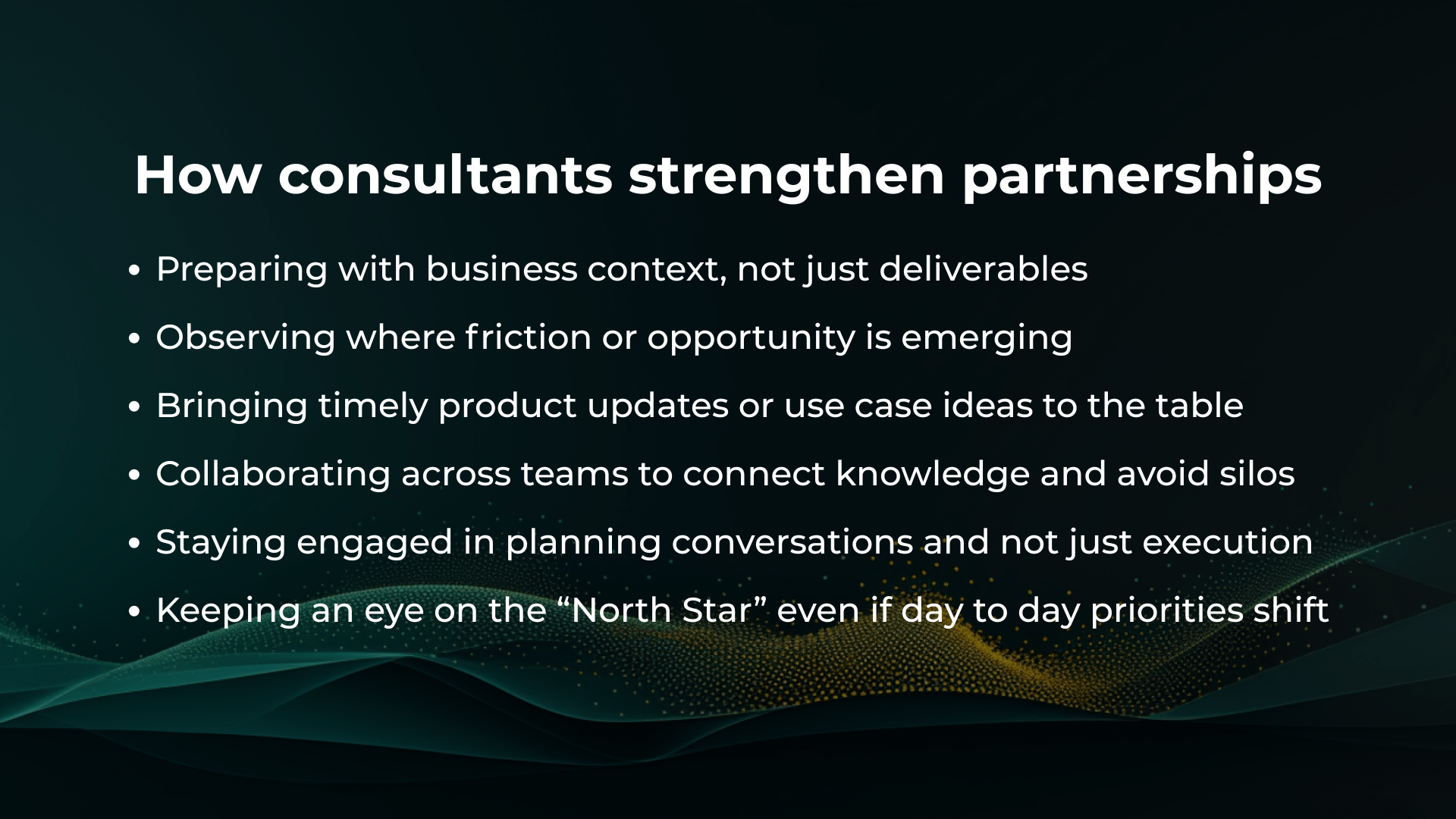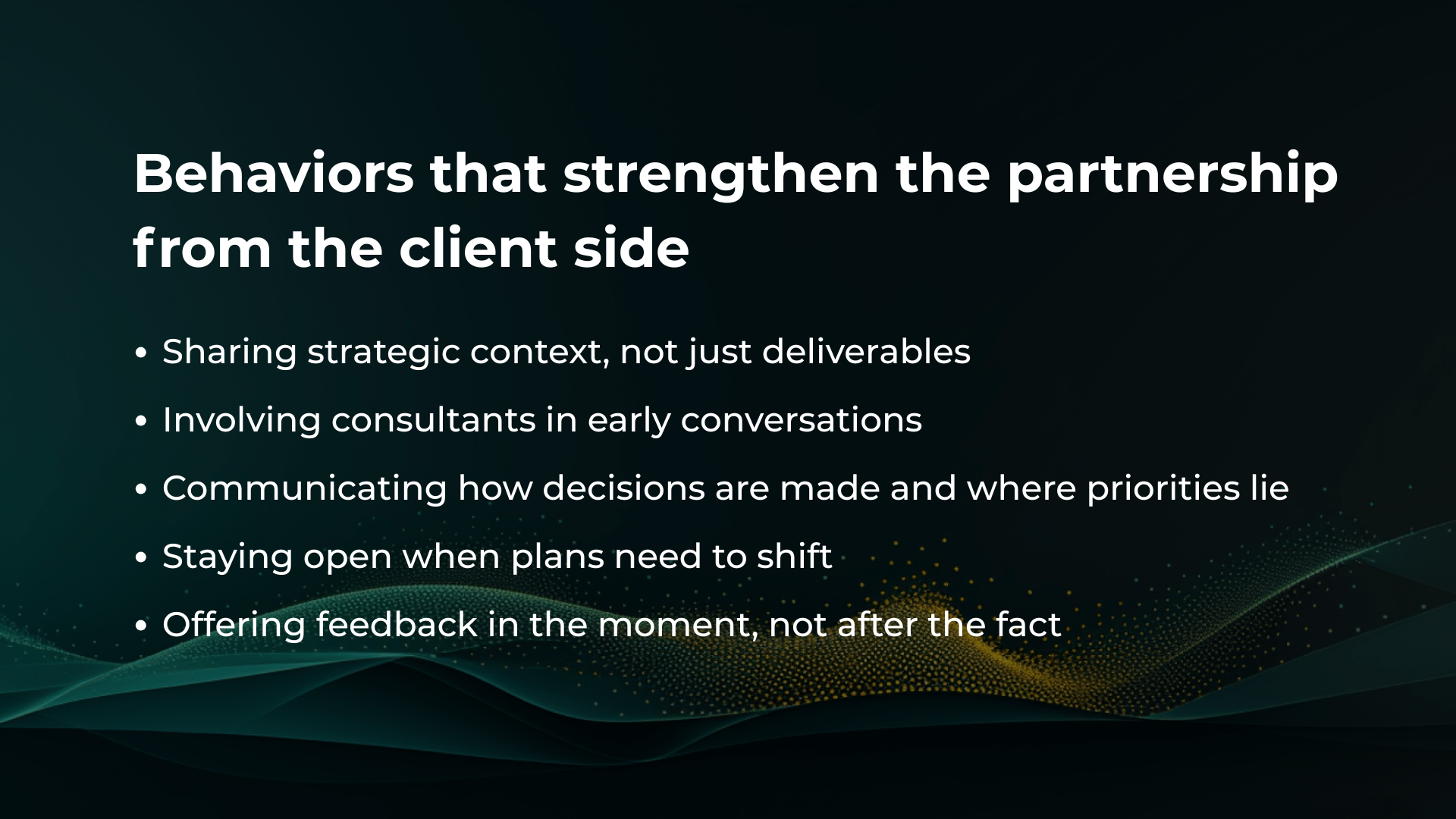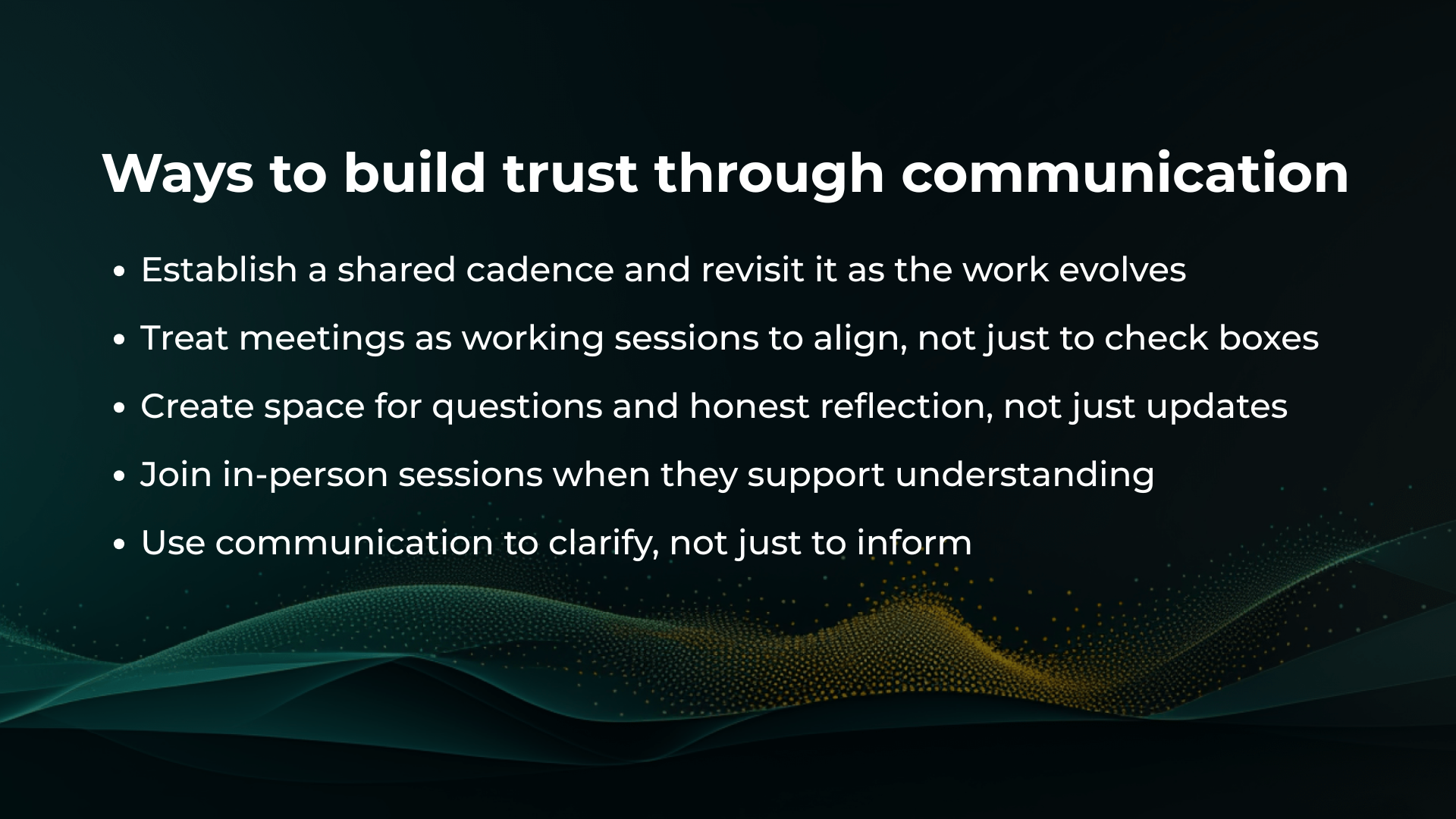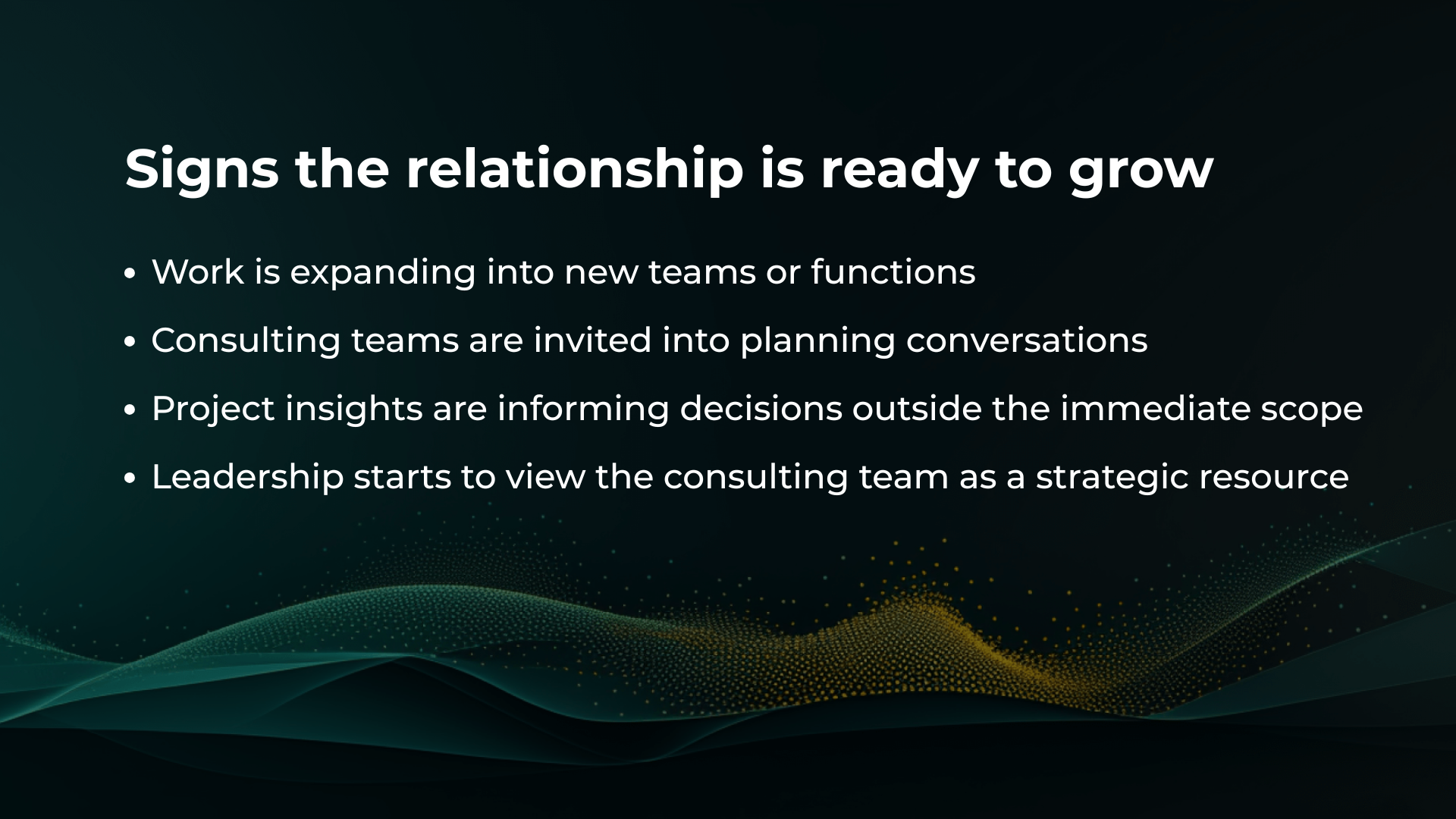What Great Client-Consultant Partnerships Look Like from Both Sides of the Table
Table of Contents
Strong client-consultant partnerships create the conditions for clarity, momentum, and long-term results. As AI, data modernization, and digital reinvention are reshaping how organizations operate, the way teams collaborate has a direct impact on outcomes.
There’s no universal playbook for partnership, but there are consistent patterns. Over the years, certain behaviors have stood out—on both sides of the table. The most effective partnerships reflect a mix of trust, transparency, and shared purpose. This blog post offers a practical look at what that looks like in the day-to-day, and where to focus when trying to build something that lasts.
How Consulting Teams Create Value That Sticks
The most impactful teams come prepared with more than a project plan. They show an interest in the client’s business, the environment they’re operating in, and the decisions they’re trying to make.
This preparation can be simple. A quick scan of an org chart, awareness of recent earnings calls or public news, or even a look at leadership messaging can shape the way conversations unfold. These details help consultants enter planning sessions and delivery meetings with better questions, more relevant examples, and ideas that fit the moment.
Once work begins, staying observant is essential. Every project offers signals—missed handoffs, shifting direction, inconsistent inputs—that point to broader trends. Consultants who observe these patterns and address them thoughtfully provide value beyond their technical expertise. They help connect the work to the outcomes the client is aiming for.
Relevance is another key area. Technology is moving fast. Consultants who track updates in tools like Copilot, Fabric, or Power Platform can offer timely suggestions that save time or improve the solution. Internal knowledge-sharing whether in Teams threads, internal recaps, or quick syncs helps to ensure that what one consultant learns, others can apply.
Consultants also make an impact by asking questions that go beyond the current scope. Not to expand the work, but to understand the bigger picture. This includes asking about timing, organizational readiness, and decision-making pressure. Insightful questions open up better solutions and allow the consultants to bring more value by understanding more.

Consultants who operate this way build relationships that outlast the project. They create confidence by delivering value consistently and staying focused on what matters to the client’s business.
Understanding the Client Perspective
Clients who share context up front make it easier for consultants to deliver value that aligns with business goals. For example, a project scoped to “build a dashboard” lands very differently when paired with an explanation like, “We’re trying to reduce time-to-close and improve visibility for our finance leaders.” When clients want more than just task completion, the relationship starts to shift
That clarity doesn’t always come from a formal requirements document. Sometimes it’s shared casually during a sync, mentioned in an internal roadmap, or referenced in a quarterly goal-setting session. Sometimes you just need to be intentional and ask, “What you are trying to achieve for the business?” When that kind of insight is part of the relationship, it creates alignment that lasts through pivots, speed bumps, or even leadership changes.
Day-to-day collaboration plays a role, too. Clients who open the door to discussions before decisions are made tend to get more input and more ownership from their consulting partners. That might look like looping consultants into early-stage planning, flagging changes in internal priorities, or even just asking, “Does this feel like it fits where we’re heading? How have you seen this tackled at other places?”
Flexibility is essential for maintaining relationships, as timelines may change, stakeholders can be added, and new initiatives may arise. Clients who are willing to stay in conversation as conditions evolve make it easier to maintain momentum without sacrificing quality.
And feedback—offered early and often—helps avoid misalignment before it compounds. Clients who provide clear direction while staying open to ideas create space for real collaboration.

When clients set the tone for transparency and collaboration, the relationship becomes more dynamic and effective. It moves from simple execution to shared progress.
Building Trust Through Consistent Communication
Trust is built in the way teams work together over time. That foundation is shaped by how information flows, how decisions are made, and how both sides stay engaged when things get busy.
One of the most effective ways to build that trust is to align early on how communication will work. Setting a cadence for check-ins, clarifying who needs to be involved at each stage, and deciding how updates will be shared helps remove friction later.
There’s no one-size-fits-all approach. Some teams benefit from weekly checkpoints. Others operate better with milestone-based touchpoints and working sessions in between. What matters is agreeing on the rhythm and making space for open conversation, not just reporting.
Steering committees work best when they support shared thinking. They create space for teams to reflect on alignment, risks, and what’s shifting in the broader business. These meetings become more valuable when they include space for questions like, “What’s changed since last month?” or “Is this work still supporting the most important goal right now?”
In-person time can deepen relationships, especially when used intentionally. Whether it’s joining a quarterly planning session, sitting in on user interviews, or walking the halls for informal conversations, physical presence often uncovers context that doesn’t come through virtually.

When communication feels purposeful, it supports stronger decisions, more confident execution, and a clearer path forward for everyone involved.
Knowing When the Relationship Is Ready to Grow
Some consulting engagements start with a narrow ask: a single report, a pilot rollout, a team-level roadmap. Over time, those small efforts often reveal more complex needs across the organization.
For example, building a dashboard for a finance team might highlight governance gaps across multiple data sources. A proof-of-concept for automation might uncover change management challenges across departments. In those moments, the opportunity to evolve the relationship starts to take shape.
The shift doesn’t need to be dramatic. It can begin with a working session to realign priorities, a quick discovery effort in another department, or an informal chat about next quarter’s goals. These moments often lead to broader conversations about how the consultant can continue to support the organization’s growth.
It helps when both sides recognize these signals early. Consultants who surface opportunities with care, and clients who remain open to input, create a partnership that adapts over time instead of restarting from scratch.

The most effective growth happens when there’s trust in place, and when both sides share a clear understanding of how the work aligns to long-term goals.
Closing Thoughts
Enduring partnerships are built in moments that don’t always show up on a slide: a well-timed question, an honest conversation, a willingness to adapt midstream. These are the habits that shape how people work together and they’re what carry the work forward once the project is done.
Clients and consultants each bring something essential to the table. When both sides stay focused on shared outcomes, keep communication open, and remain curious about what’s possible, the relationship becomes something more than a contract. It becomes a way to grow together.
